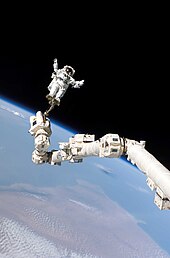STS-114
29 months) after the loss of Columbia, was approved despite unresolved fuel sensor anomalies in the external tank that had prevented the shuttle from launching on July 13, its originally scheduled date.Analysis of the launch footage showed debris separating from the external tank during ascent; this was of particular concern because it was the issue that had set off the Columbia disaster.The flight carried the Raffaello Multi-Purpose Logistics Module, built by the Italian Space Agency, as well as the External Stowage Platform-2, which was mounted to the port side of the Quest Airlock.The CMG was carried up on the LMC (Lightweight Multi-Purpose Experiment Support Structure Carrier) at the rear of the payload bay, together with the TPS Repair Box.The debris was thought to have measured 36.3 by 11 by 6.7 inches (922 by 279 by 170 mm) – and to weigh about 0.45 kilograms (0.99 lb), or half as much as the piece of foam blamed for the loss of Columbia.Based on the mass of the foam, and the velocity at which it would have struck the wing, NASA estimated it only exerted one-tenth the energy required to cause potential damage.As with Columbia, NASA at first believed that workers' improper installation and handling of the external tanks at the Michoud Assembly Facility in Louisiana caused the foam loss on Discovery.With the destruction suffered by Michoud and NASA's Stennis Space Center in Mississippi due to Hurricane Katrina and the subsequent flooding, the launch of the next shuttle mission (STS-121) was further delayed until July 4, 2006.In December 2005 x-ray photographs of another tank showed that thermal expansion and contraction during filling, not human error, caused the cracks that resulted in foam loss.One filler prevents "chattering" of tiles during ascent, which would occur due to the shock waves from the noses of the solid rocket boosters and the external fuel tank.Stephen K. Robinson gave a running commentary of his work: "I'm grasping it and I'm pulling it and it's coming out very easily" ... "It looks like this big patient is cured".Protruding gap fillers were a problem because they disrupted the normally laminar air flow under the orbiter during reentry, causing turbulence at lower speeds.A further in-flight repair was considered to remove or clip a damaged thermal blanket located beneath the commander's window on the port side of the orbiter.Wind tunnel testing by NASA determined that the thermal blanket was safe for re-entry, and plans for a fourth spacewalk were cancelled.Nikolay Sevastyanov, director of the Russian Space Corporation Energia, was reported by Pravda as saying: "If necessary, we will be able to bring home nine astronauts on board three Soyuz spacecraft in January and February of the next year".
















rendezvous pitch maneuverSpace Transportation SystemCOSPAR IDSATCAT no.Space ShuttleDiscoveryEileen M. CollinsJames M. KellySoichi NoguchiStephen K. RobinsonAndrew S. W. ThomasWendy B. LawrenceCharles J. CamardaKennedyLC-39BEdwardsGeocentricLow EarthPerigee altitudeApogee altitudeInclinationPeriodSpace Shuttle programSTS-107STS-121Space Shuttle Columbia disasterexternal tankEdwards Air Force BaseKennedy Space CenterPositionEileen CollinsJim KellyStephen RobinsonYuri MalenchenkoExpedition 7Ken BowersoxExpedition 6Nikolai BudarinAleksandr KaleriDonald PettitSpace Shuttle DiscoverySTS-93AtlantisSTS-26International Space StationOrbiter Boom Sensor SystemCanadarmLaser Dynamic Range ImagerThermal Protection SystemMulti-Purpose Logistics ModuleItalian Space AgencyExternal Stowage PlatformControl Moment GyroscopesspacewalksAtmospheric reentrybird struckDiscovery'sexternal fuel tankliquid oxygenMichoud Assembly FacilityMichael GriffinAha! effectHurricane KatrinaGulf CoastNASA'sStennis Space CenterMississippix-ray photographsthermal expansionWayne Haleshock wavesceramiclaminar air flowturbulenceSTS-28STS-73Wayback MachineAstrovanNoguchiRobinsonspacewalkamateur radio satellitePCSat2ISS crewWhite Sands, New MexicoSTS-111STS-48Ken HamdeorbitMadagascarcontrol surfacesGemini programApollo 15I Got You BabeSonny & CherLouis ArmstrongCharles CamardaVertigoJames KellyMy Neighbor TotoroJoe HisaishiClaire LynchWendy LawrenceWalk of LifeDire StraitsSteve RobinsonHarry McClintockAndy ThomasRussell WatsonAmarillo by MorningGeorge StraitThe One and Only Flower in the WorldCome On EileenDexys Midnight RunnersGood Day SunshineThe BeatlesRick Husband'sSTS-300Soyuz spacecraftNikolay SevastyanovEnergiaPravda2005 in spaceflightList of human spaceflightsList of human spaceflights to the ISSList of Space Shuttle missions